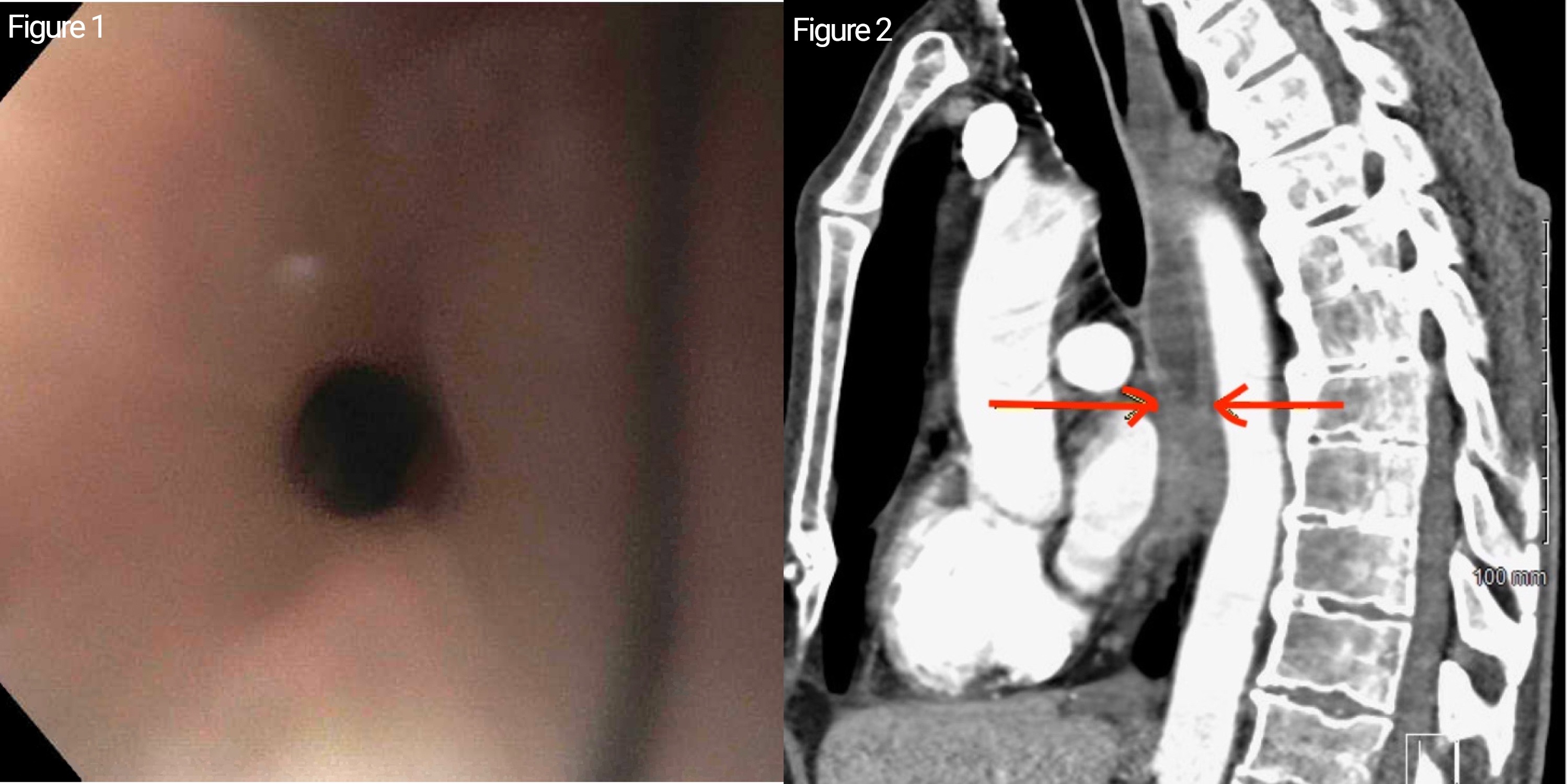Monday Poster Session
Category: Esophagus
P1879 - A Novel Case of Esophageal Dysphagia Secondary to Extrinsic Compression by Metastatic Invasive Ductal Carcinoma in a 79-Year-Old Male
Monday, October 23, 2023
10:30 AM - 4:15 PM PT
Location: Exhibit Hall

Has Audio

Ahmet Sakiri, MD
MercyHealth
Rockford, IL
Presenting Author(s)
Ahmet Sakiri, MD, Mudassar Sandozi, DO, Sabah Mahmood, MD, Andrew Tannenbaum, MD, Thayer Hamoudah, MD, Altaf Dawood, MD, MBBS, Naser Khan, MD
MercyHealth, Rockford, IL
Introduction: 1 in 25 Americans report experiences of dysphagia. Etiologies of esophageal dysphagia include mechanical obstruction, motility disorders, or functional dysphagia. In rare cases, extrinsic compression can be a cause. We present a unique case of esophageal dysphagia secondary to extrinsic compression by an invasive breast ductal carcinoma lesion in a male.
Case Description/Methods: A 79-year-old male with hypertension and hyperlipidemia presented with 10 lbs of weight loss and progressive dysphagia, initially to solids and then to liquids. CT chest with IV contrast revealed a 2 x 3 x 4 cm mass lesion at the junction of the middle and distal third of the esophagus with evidence of esophageal obstruction. Initial EGD revealed a 5 mm pinpoint stenosis 34 cm distal from the incisors that could not be traversed (Figure 1). Balloon dilation was performed to 12 mm with TTS dilator. Biopsies obtained via cold forceps were negative for malignancy. Symptoms improved, and the patient was discharged. However, the patient returned to the ED within 1 week for recurrence of dysphagia. Physical examination revealed small subcutaneous nodules throughout the body, including the left breast. A repeat CT chest demonstrated a mediastinal mass circumventing the descending aorta and extrinsically obstructing the distal third of the esophagus (Figure 2). Subcutaneous nodules in the anterior left chest wall and right gluteal region suspicious for metastatic foci were present. An US-guided core needle biopsies of the subcutaneous lesions, including the left breast nodule, revealed Grade II triple negative invasive ductal carcinoma. The patient opted for IR guided PEG tube placement, opposed to esophageal stenting. Patient was referred to hematology- oncology to pursue further treatment options.
Discussion: Endoscopic intervention is necessary to evaluate and treat dysphagia, but extrinsic esophageal compression poses a challenge as it responds poorly to dilation and may require stent placement. 1% of breast cancers in the US occur in men, with ER+ and Her2 negative invasive ductal carcinoma being the most common subtype. In women, reports of dysphagia secondary to breast cancer metastasis are infrequent. This is the only identified case of dysphagia from extrinsic compression by metastatic invasive ductal carcinoma in a male. This case gives credence to the possibility of metastatic breast cancer as a rare cause of extrinsic esophageal compression in males presenting with dysphagia.

Disclosures:
Ahmet Sakiri, MD, Mudassar Sandozi, DO, Sabah Mahmood, MD, Andrew Tannenbaum, MD, Thayer Hamoudah, MD, Altaf Dawood, MD, MBBS, Naser Khan, MD. P1879 - A Novel Case of Esophageal Dysphagia Secondary to Extrinsic Compression by Metastatic Invasive Ductal Carcinoma in a 79-Year-Old Male, ACG 2023 Annual Scientific Meeting Abstracts. Vancouver, BC, Canada: American College of Gastroenterology.
MercyHealth, Rockford, IL
Introduction: 1 in 25 Americans report experiences of dysphagia. Etiologies of esophageal dysphagia include mechanical obstruction, motility disorders, or functional dysphagia. In rare cases, extrinsic compression can be a cause. We present a unique case of esophageal dysphagia secondary to extrinsic compression by an invasive breast ductal carcinoma lesion in a male.
Case Description/Methods: A 79-year-old male with hypertension and hyperlipidemia presented with 10 lbs of weight loss and progressive dysphagia, initially to solids and then to liquids. CT chest with IV contrast revealed a 2 x 3 x 4 cm mass lesion at the junction of the middle and distal third of the esophagus with evidence of esophageal obstruction. Initial EGD revealed a 5 mm pinpoint stenosis 34 cm distal from the incisors that could not be traversed (Figure 1). Balloon dilation was performed to 12 mm with TTS dilator. Biopsies obtained via cold forceps were negative for malignancy. Symptoms improved, and the patient was discharged. However, the patient returned to the ED within 1 week for recurrence of dysphagia. Physical examination revealed small subcutaneous nodules throughout the body, including the left breast. A repeat CT chest demonstrated a mediastinal mass circumventing the descending aorta and extrinsically obstructing the distal third of the esophagus (Figure 2). Subcutaneous nodules in the anterior left chest wall and right gluteal region suspicious for metastatic foci were present. An US-guided core needle biopsies of the subcutaneous lesions, including the left breast nodule, revealed Grade II triple negative invasive ductal carcinoma. The patient opted for IR guided PEG tube placement, opposed to esophageal stenting. Patient was referred to hematology- oncology to pursue further treatment options.
Discussion: Endoscopic intervention is necessary to evaluate and treat dysphagia, but extrinsic esophageal compression poses a challenge as it responds poorly to dilation and may require stent placement. 1% of breast cancers in the US occur in men, with ER+ and Her2 negative invasive ductal carcinoma being the most common subtype. In women, reports of dysphagia secondary to breast cancer metastasis are infrequent. This is the only identified case of dysphagia from extrinsic compression by metastatic invasive ductal carcinoma in a male. This case gives credence to the possibility of metastatic breast cancer as a rare cause of extrinsic esophageal compression in males presenting with dysphagia.

Figure: Figure 1: EGD view of pinpoint esophageal stenosis. Figure 2: CT Chest highlighting esophageal compression by invasive ductal carcinoma (arrows)
Disclosures:
Ahmet Sakiri indicated no relevant financial relationships.
Mudassar Sandozi indicated no relevant financial relationships.
Sabah Mahmood indicated no relevant financial relationships.
Andrew Tannenbaum indicated no relevant financial relationships.
Thayer Hamoudah indicated no relevant financial relationships.
Altaf Dawood indicated no relevant financial relationships.
Naser Khan indicated no relevant financial relationships.
Ahmet Sakiri, MD, Mudassar Sandozi, DO, Sabah Mahmood, MD, Andrew Tannenbaum, MD, Thayer Hamoudah, MD, Altaf Dawood, MD, MBBS, Naser Khan, MD. P1879 - A Novel Case of Esophageal Dysphagia Secondary to Extrinsic Compression by Metastatic Invasive Ductal Carcinoma in a 79-Year-Old Male, ACG 2023 Annual Scientific Meeting Abstracts. Vancouver, BC, Canada: American College of Gastroenterology.
